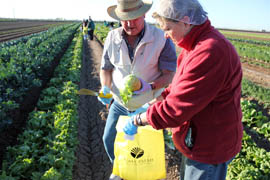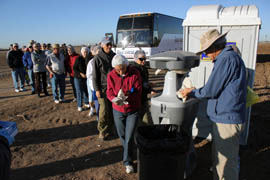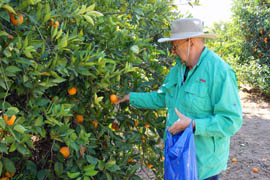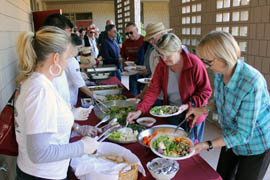Cronkite News has moved to a new home at cronkitenews.azpbs.org. Use this site to search archives from 2011 to May 2015. You can search the new site for current stories.
Field to Feast: Farm-rich Yuma out to capitalize on growth of agritourism
YUMA – Wearing hairnets and blue latex gloves, Holly Liddiard and her husband, Gary, amble into a field to pick vegetables. All for the fun of it.
Two notecards carry their assignments: Return with kale and a head of lettuce.
Several dozen others in their group, brought here in a bus and similarly clad, head off with cards requesting green onions, cabbage, broccoli and more.
For the Liddiards, residents of Courtenay, British Columbia, this is an opportunity to learn more about the main industry in Yuma, where they’ve spent several winters now.
“We really enjoy this area because of all the agriculture,” Holly said. “There’s always something to see.”
The Yuma Visitors Bureau tour, dubbed Field to Feast, engages tourists, snowbirds and locals with the processes and precautions required to get produce from soil to table. It’s one way officials are trying to position this southwestern Arizona community as a center of agritourism.
“It is an amazing industry, and it’s important to share it with people who visit Yuma,” said Kristan Sheppeard, the bureau’s director of agritourism, sales and marketing.
Her organization also offers a Farmer to Farmer tour, which allows professionals from around the country see how produce is grown in Yuma, and Taco Trail tours connecting locals and visitors with restaurants featuring locally grown produce.
Agritourism is farm–based recreation ranging from hunting and fishing to hay rides to educational tours to allowing visitors to pick their own produce, according to the U.S. Department of Agriculture. In 2004, about 52,000 farms – 2.5 percent of the total – earned money from agritourism, according to the USDA’s Economic Research Service.
Julie Murphree, an Arizona Farm Bureau spokeswoman, said agritourism can help cash flow for farms because the state’s warm weather makes it a viable option year–round, unlike in colder states. Farmers are starting to see opportunity in helping people learn more about farming, she said.
“It is one of the most unique ways to connect Arizona families to agriculture,” Murphree said.
Queen Creek, southeast of Phoenix, has one of the country’s best–known agritourism locations in Schnepf Farms, a 70–year–old family operation. About 18 years ago, under threat of having to sell the farm, the family began offering concerts, corn mazes, amusement park–style rides and more, all while continuing to grow crops.
“We had to create a different economic dynamic,” owner Mark Schnepf said. “There’s nothing like it, quite frankly.”
Yuma’s agritourism ventures have drawn hundreds of visitors over the past two years, and the Field to Feast tours have expanded from several last year to 14 this year.
Hank Auza, farm manager of Barkley Co. of Arizona, one of the area’s largest producers, said farmers benefit from the exchange.
“We just want to promote our industry,” he said. “We feed all of the United States out of our little corner of the world.”
On the Field to Feast tour, visitors learn first–hand about food–safety practices, down to having to wash their hands and wear gloves before heading into the vegetable field. Area farmers meet with small groups to explain how they do their jobs, including irrigation, the equipment they use, how they level fields and ways they prevent contamination of crops.
Later, the group headed to a citrus orchard, where Carol Gilman of Clarkston, Wash., got to pick oranges and learn how citrus farming has declined around the state in recent years.
“I’m learning something all the time,” she said.
Most of the tour involved riding through Yuma’s farmland as a guide pointed out facts about agriculture. At a flooded field, the guide explained how GPS–aided leveling and plowing maximizes the benefits of irrigation. Another field allowed her to show how staggered planting allows farmers to harvest throughout the season.
The tour concluded at Arizona Western College, where culinary arts students prepared lunch with produce grown in fields the group visited. The menu included lettuce wraps with dipping sauce, tossed salad, fresh oranges and lemonade.
Cecilia Vigil, associate dean for the school’s Division of Science, Mathematics and Agriculture, said the experience has a lasting impact on tourists’ attitudes toward farming and the outdoors.
“When you’re educated, you’re going to take care of the environment more because you know where everything comes from,” she said.












